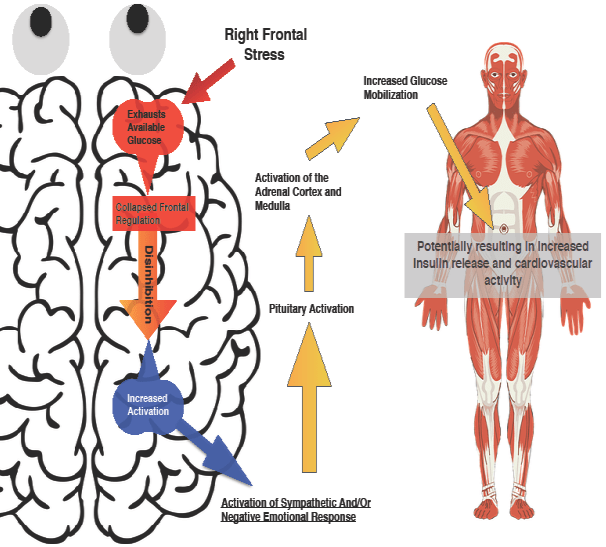1. Cox DJ, Taylor AG, Nowacek G, Holley-Wilcox P, Pohl SL, Guthrow E. The relationship between psychological stress and insulin-dependent diabetic blood glucose control: Preliminary investigations. Health Psychol. 1984; 3(1): 63-75. doi: 10.1037/0278-6133.3.1.63
2. Walters RP, Harrison PK, Campbell RW, Harrison DW. Frontal lobe regulation of blood glucose levels: Support for the limited capacity model in hostile violence-prone men. Brain Inform. 2016; 3(4): 221-231. doi: 10.1007/s40708-016-0034-6
3. Walters RP, Harrison PK, DeVore BB, Harrison DW. Capacity theory: A neuropsychological perspective on shared neural systems regulating hostile violence prone behavior and the metabolic syndrome. Austin J Neurological Disorders Epilepsy. 2016; 3(1): 1014-1030. Web site. http://austinpublishinggroup.com/neurological-disorders-epilepsy/fulltext/ajnde-v3-id1014.php. Accessed February 14, 2017.
4. Cox DE, Harrison DW. Models of anger: Contributions from psychophysiology, neuropsychology and the cognitive behavioral perspective. Brain Struct Funct. 2008; 212(5): 371-385. doi: 10.1007/s00429-007-0168-7
5. Davidson RJ, Putnam KM, Larson CL. Dysfunction in the neural circuitry of emotion regulation–a possible prelude to violence. Science. 2000; 289(5479): 591-594. doi: 10.1126/science.289.5479.591
6. Harrison DW. Frontal Lobe Syndromes. In: Brain Asymmetry and Neural Systems. Berlin, Germany: Systems Springer International Publishing; 2015: 267-321. doi: 10.1007/978-3-319-13069-9
7. Demaree HA, Everhart DE, Youngstrom EA, Harrison DW. Brain lateralization of emotional processing: Historical roots and a future incorporating “dominance”. Behav Cogn Neurosci Rev. 2005; 4(1): 3-20. Web site. http://journals.sagepub.com/doi/abs/10.1177/1534582305276837. Accessed February 14, 2017.
8. Harrison DW. Positive and Negative Emotion. In: Brain Asymmetry and Neural Systems. Berlin, Germany: Springer International Publishing; 2015: 389-413. doi: 10.1007/978-3-319-13069-9_22
9. Harrison DW. Parasympathetic and Sympathetic Tone. In: Brain Asymmetry and Neural Systems. Berlin, Germany: Springer International Publishing; 2015: 441-453. doi: 10.1007/978-3-319-13069-9_26
10. Heilman KM, Schwartz H, Watson RT. Hypoarousal in patients with the neglect syndrome and emotional indifference. Neurology. 1978; 28(3): 229-232. doi: 10.1212/WNL.28.3.229
11. Carmona JE, Holland AK, Harrison DW. Extending the functional cerebral systems theory of emotion to the vestibular modality: A systematic and integrative approach. Psychol Bull. 2009; 135(2): 286-302. doi: 10.1037/a0014825
12. Luria AR. Higher Cortical Functions in Man. New York, USA: Basic Books; 1966. doi: 10.1007/978-1-4615-8579-4
13. Luria AR. The Working Brain: An Introduction to Neuropsychology. New York, USA: Basic Books, Inc., Publishers; 1973.
14. Luria AR. Higher Cortical Functions in Man. 2nd ed. New York, USA: Basic Books, Inc., Publishers; 1980.
15. Heilman KM, Bowers D, Valenstein E. Emotional disorders associated with neurological diseases. Clinical neuropsychology. 1993; 3: 461-97.
16. Holland AK, Carmona JE, Harrison DW. An extension of the functional cerebral systems approach to hostility: A capacity model utilizing a dual concurrent task paradigm. J Clin Exp Neuropsychol. 2012; 34(1): 92-106. doi: 10.1080/13803395.2011.623119
17. Oppenheimer SM, Gelb A, Girvin JP, Hachinski VC. Cardiovascular effects of human insular cortex stimulation. Neurology. 1992; 42(9): 1727-1727. doi: 10.1212/WNL.42.9.1727
18. Hilz MJ, Dütsch M, Perrine K, Nelson PK, Rauhut U, Devinsky O. Hemispheric influence on autonomic modulation and baroreflex sensitivity. Ann Neurol. 2001; 49(5): 575-584. doi: 10.1002/ana.1006
19. Comer CS, Harrison PK, Harrison DW. The dynamic opponent relativity model: An integration and extension of capacity theory and existing theoretical perspectives on the neuropsychology of arousal and emotion. Springerplus. 2015; 4(1): 345. doi: 10.1186/s40064-015-1120-6
20. Wittling W, Block A, Genzel S, Schweiger E. Hemisphere asymmetry in parasympathetic control of the heart. Neuropsychologia. 1998; 36(5): 461-468. doi: 10.1016/S0028-3932(97)00129-2
21. Peyrot MF, McMurry JF. Stress buffering and glycemic control: The role of coping styles. Diabetes care. 1992; 15(7): 842-846. doi: 10.2337/diacare.15.7.842






